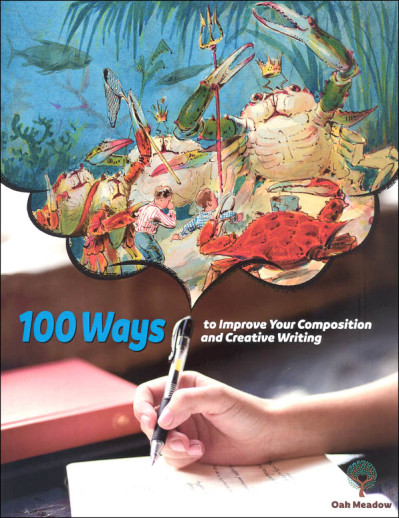We use cookies to make your experience better. To comply with the new e-Privacy directive, we need to ask for your consent to set the cookies. Learn more.
100 Ways to Improve Your Composition and Creative Writing
Writing should be an exciting subject, entered into as an adventure. There are so many types of writing that every assignment could be enjoyable! Writing for 100 Days by Gabriel Arquilevich, is well-known for its ability to draw a student into writing. Now updated to 100 Ways to Improve Your Composition and Creative Writing all the same engaging and user-friendly elements have been preserved. So many students get burned out on writing before they've hardly begun, bogged down by complex grammar rules, inflexible formats, and uninteresting assignments. It shouldn't be that way.
Predictably, the book contains 100 lessons, divided into four categories; composition, fiction, poetry, and writing in action. The lessons are short, flexible, and structured for use by the student alone, or for a teacher and student(s). The book kicks off with word usage and a review of punctuation. However, this is only brief review, and though exercises are given, supplemental practice would be helpful to keep those skills fresh. After the basics are reviewed; writing process, punctuation, construction, tone, and style are covered in Composition. Fiction covers character creation, setting, plot, dialogue, and point of view. Poetry covers haiku, limericks, sonnet, free and blank verse, song lyrics, and more. Writing in Action (the largest section) contains instruction on writing as part of daily life, such as business and personal letters, interviews, advertisements, reviews, columns, diaries, and greeting cards. The lessons, each covering a major facet of the big topic, are divided into two parts, the lesson and the writing.
Brief instruction is included with each assignment and is clearly written and reader-friendly; including many examples. But, the fun part is putting into action what you have just learned. The short assignments leave room for lots of creativity. Sometimes short assignments are parts of a larger composition and lead into a longer assignment or series of longer assignments such as when the student is working on a short story. Beware! The teacher/parent will be a lot happier if they are comfortable correcting grammar usage and mechanics as no answer key is included.
This course is truly a "breath of fresh air" for any student, but especially to one who is having a hard time really enjoying the art of writing. 116 pages, pb. - Jess
Junior high and high school students will delight in this friendly, day-by-day guide to writing. From the intricacy of sentence structure to the complexity of the essays, this book is a comprehensive, engaging introduction to writing. Compostition-- A step beyond the rudimentary rules of usage and punctuation, these forty-eight days focus on word choice, sentence structure, style, and more. A variety of related (and original!) exercises and writing activities help bring learning into application. Included is a look at dashes, parentheses, colons, and semicolons. Fiction-- Beginning with character development, students lay the groundwork for a story in eighteen days. Studies of dialogue and point of view are provided. Poetry-- In these eight days, students practice a variety of forms, from the sonnet to song lyrics. Also included is a look at line break and imagery. Writing in Action-- These twenty-six days introduce the student to a variety of nonfiction forms, including letter writing, speech writing, technical writing, journalism and advertising. This section also includes some unusual assignments and some word games. In short,100 Ways to Improve Your Composition and Creative Writing is a valuable resource, offering a refreshing alternative to the standard textbook.
These materials contain both instruction and writing assignments but are not as broad in scope (types of writing) as the comprehensive programs.
| Product Format: | Softcover Book |
|---|---|
| Brand: | Oak Meadow |
| Author: | Gabriel Arquilevich |
| Grades: | 8-12 |
| ISBN: | 9781684271092 |
| Length in Inches: | 11 |
| Width in Inches: | 8.4375 |
| Height in Inches: | 0.25 |
| Weight in Pounds: | 0.65 |

